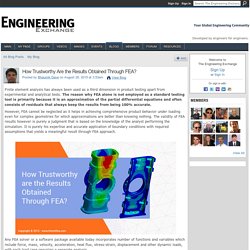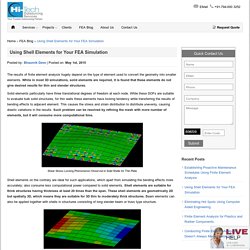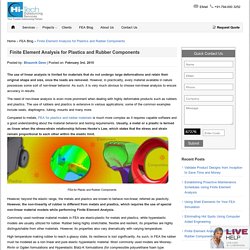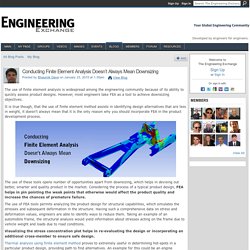

Bhaumik Dave
Hi-tech FEA is Leading FEA Consulting service provider firm offering FEA Analysis services, Static & Dynamic, Vibration, Fatigue, Coupled Field Analysis services at low cost.
How Trustworthy Are the Results Obtained Through FEA? Finite element analysis has always been used as a third dimension in product testing apart from experimental and analytical tests.

The reason why FEA alone is not employed as a standard testing tool is primarily because it is an approximation of the partial differential equations and often consists of residuals that always keep the results from being 100% accurate. However, FEA cannot be neglected as it helps in achieving comprehensive product behavior under loading even for complex geometries for which approximations are better than knowing nothing. The validity of FEA results however is purely a judgment that is based on the knowledge of the analyst performing the simulation. It is purely his expertise and accurate application of boundary conditions with required assumptions that yields a meaningful result through FEA approach. However, modern simulation tools have become much easier allowing non-experts to easily model the problem.
About Author: Bhaumik Dave is a Sr. How Computer Aided Engineering Can Help Unconventional Product Designs. Products are getting smarter every day, and are becoming more personalized and largely different from conventional designs.

The modern engineering community as such has to rely on new set of design and development tools against the conventional ones. It is also quite difficult to conduct physical experiments for these new breed of technologically advanced and customized products designed to meet specific requirements of customers.
For any such product where physical examination is difficult or too complex and costly, computer aided engineering techniques can help. It provides a quick design solution by simulating the real world effects through a set of mathematical algorithms. Both the realms of CAE – Computational Fluid Dynamics and Finite Element Structural Analysis can be utilized to study the behavior of the product, without worrying about the unconventional design constraints added in the product for customization.
Establishing Proactive Maintenance Schedules Using Finite Element Analysis. Any engineered product’s success rate hugely depends on the amount of useful life it delivers.

As conventional designs continue evolving for the sake of improving performance, it has become mandatory for design engineers to adopt new ways to determine and increase product life, while downsizing and reducing the development cost. The use of finite element analysis is as such being increasingly adopted by engineers to evaluate the product virtually, prior to making any change in the design. The use of simulation helps in determining key design parameters that affect the performance and life of the product, which can be improved further to ensure a longer lasting product. Since the number of physical tests can be reduced, the cost of making a safe design is also nominal. However, the simultaneous results obtained through FEA can also be utilized to determine the warranty and maintenance costs for equipments and helps in establishing proactive maintenance schedules effectively.
Using Shell Elements for Your FEA Simulation. The results of finite element analysis hugely depend on the type of element used to convert the geometry into smaller elements.

While in most 3D simulations, solid elements are required, it is found that these elements do not give desired results for thin and slender structures. Solid elements particularly have three translational degrees of freedom at each node. While these DOFs are suitable to evaluate bulk solid structures, for thin walls these elements have locking tendency while transferring the results of bending effects to adjacent element. This causes the stress and strain distribution to distribute unevenly, causing drastic variations in the results. 10 Mistakes that makes you pay more for Finite Element Analysis (FEA) Finite Element Analysis (FEA) is an essential aspect of product design in most industry sectors.

In spite FEA being so important manufacturers don’t focus on it much or sometimes ignore it. Stress Analysis different Aspects, Advantages of Stress Analysis Services. Eliminating Hot Spots Using Computer Aided Engineering. Most engineering products involve their application under extreme thermal environments.

Examples could range from electronic components such as microprocessors to mechanical devices such as turbines, compressors and engines. All these devices are exposed to high temperatures, causing possible damage due to thermal stresses and subsequent deformation. One of the prime concerns for design engineers in such cases is to avoid building up of thermal concentrated regions often referred to as hot-spots. Moreover, with increasing requirement from the market to build compact products, the situation is even more challenging to engineers in designing products that remain thermally uniform during their applications.
Product design using computer aided engineering. A hot spot can be imagined in a thermally sensitive product such as a heat exchanger utilized in industrial applications. Evaluating the hot spot experimentally is quite time consuming and requires complex physical setup. Finite Element Analysis for Plastics and Rubber Components. The use of linear analysis is limited for materials that do not undergo large deformations and retain their original shape and size, once the loads are removed.

However, in practicality, every material available in nature possesses some sort of non-linear behavior. As such, it is very much obvious to choose non-linear analysis to ensure accuracy in results. The need of non-linear analysis is even more prominent when dealing with highly deformable products such as rubbers and plastics. The use of rubbers and plastics is extensive in various applications; some of the common examples include seals, diaphragms, tubing, mounts and many more.
Compared to metals, FEA for plastics and rubber materials is much more complex as it requires capable software and a good understanding about the material behavior and testing requirements. FEA for Plastic and Rubber Components However, beyond the elastic range, the metals and plastics are known to behave non-linear, referred as plasticity. Image Credit:
Conducting Finite Element Analysis Doesn’t Always Mean Downsizing. The use of finite element analysis is widespread among the engineering community because of its ability to quickly assess product designs.

However, most engineers take FEA as a tool to achieve downsizing objectives. It is true though, that the use of finite element method assists in identifying design alternatives that are less in weight, it doesn’t always mean that it is the only reason why you should incorporate FEA in the product development process. Why Verification and Validation Should Be A Part of FEA Studies? Finite element analysis is a numerical approach to evaluate solid mechanics problems.

Today, most engineers utilize this approach as a means to assess the product design performance. FEA however requires creating a mathematical model from the CAD model by defining the geometry, loads and constraints along with the type of analysis required to be performed such as structural or thermal. During this conversion process of a CAD model to mathematical one, many assumptions are being made for simplifications, which give rise to the chances of errors in the results. As such it is crucial for engineers to verify the accuracy of the FEA solver and also validate the results against experimental tests, in order to ensure an error-free finalized design. A mathematical model requires discretization into number of finite elements, which is termed as meshing. However, improper selection of meshing elements or mesh size leads to errors in the solution, which are also known as discretization errors.
FEA Analysis Services: For Better Designs and Increased Productivity. How to Ensure Product Performance and Reliability with Finite Element Analysis? Strengthening Automobile Chassis Using Finite Element Analysis. A chassis provides the much needed support to the vehicle body, and bears number of loads in order make sure that they do not get transmitted inside the cabin.

In general, the chassis has to accommodate five loading conditions that include bending, torsion, combined bending and torsion, lateral and fore & aft loading. These loads generate due to vehicle motion, its maneuvering and uneven road conditions. Achieving Sustainability Goals Using Finite Element Analysis. Automotive Engine Downsizing with Finite Element Analysis. Modern automobile engines are required to face numerous challenges apart from its ability to churn out maximum power through efficient fuel burning.
As global market and government regulations are increasingly getting stringent, the engines are to be designed to give out more with fewer amounts of resources.Factors such as weight, emission characteristics and performance remain vital for engine designers, requiring to adopt modern computer aided simulation techniques and identify ways to trim down the engine size as much as possible while also ensuring that the engine develops the same or even more power output. Designing lightweight engines brings along a lot of advantages such as improved power to weight ratio, reduced exhaust emissions, increased cost savings in terms of material required and finally an overall reduction in weight of the vehicle to obtain better efficiency.
Automotive Engine Downsizing with Finite Element Analysis/center> (Image Source: www.iav.com) Predicting Fatigue in Pressure Vessels Using Finite Element Analysis. The purpose of pressure vessels is to store gases and liquids at pressure range different from ambient conditions. Selecting a pressure vessel for specific application requires understanding the internal pressure conditions that generate forces on the walls of the vessels that subsequently generate stress and deformation.
A prolonged exposure of the vessel to extreme forces from the high pressurized fluid can affect the fatigue life through the development and growth of cracks, leading to catastrophic failure. Diving Deeper into Vehicle Development Using Finite Element Analysis. There’s nothing new about utilizing finite element analysis to evaluate automotive component designs for structural, thermal and fatigue strengths.
However, with modern solver capabilities, taking a deeper dive into vehicular development using finite element analysis is possible. Today, software capabilities are not simply restricted to calculating stress and deformation characteristics of the component, but can be utilized to uncover wealth of information. Let’s look at some of the most deeply automotive focused applications of finite element analysis, which catapult towards comprehensive vehicle development.
(Image Source: www.simpact.co.uk) 5 Tips to Help You Successfully Perform Thermal Analysis Using FEA. Different Types of Thermal Analysis, FEA Modeling. Achieving Sustainability Goals Using Finite Element Analysis. FEA for Material Selection – Ensuring a High Performance Product Design. Application of Computational Method for Cricket Bat Designers.